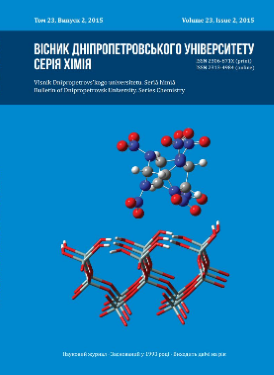Effect of acrylonitrile on the electrode processes ivolving copper cations
DOI:
https://doi.org/10.15421/081514Keywords:
copper electrodeposition, anodic processes, acrylonitrile, cyclic voltammetryAbstract
Based on the results of cyclic voltammetry and study of deposits morphology, it has been shown that acrylonitrile does not have significant effect on the mechanism of Cu2+ + 2ē → Cu0 reaction. This distinguishes acrylonitrile from the unsaturated polyfunctional organic substances (acrylic acid, acrylamide) which forms stable complexes with Cu2+ ions. Acrylonitrile just inhibits cathodic process by adsorbing on the surface of electrode thus blocking its active sites. But the presence of acrylonitrile significantly changes the mechanism of the anodic process. It has been found that acrylonitrile interacts with surface copper atoms thus forming thermodynamically stable [Cu π-AN]0 π‑complexes. Ionization potential of these π‑complexes is more negative if compare to copper atoms. As the result acceleration of anodic process takes place in the low polarization area. However, since the chemisorption is a slow process the presence of acrylonitrile mainly affects dissolution of the first surface layers of copper atoms. Further ionization of copper atoms runs out directly and requires higher polarization.References
Gamaly, I. V., & Samsonov, A. I. (1984). [Investigation of the effect of acrylic acid on the copper electrodeposition and corrosion using probe indicator microelectrode]. Russian Electrochemistry, 20(11), 1488–1492.
Vargalyuk, V. F., Loshkarev, Y. M., Polonskyy, V. A., & Horoshavkina, N. V. (1986). [Kinetics and mechanism of copper (II) electroreduction in the presence of some unsaturated organic compounds. Allyl alcohol]. Russian Electrochemistry, 22(9), 1229–1231.
Vargalyuk, V. F., Polonskii, V. A., Stets, O. S., & Balalaev, O. K. (2013). [Structure and properties of copper electrodeposited from sulphate solutions with acrylic acid and acrylamide]. Ukr. Chem. J., 79(3), 51–58.
Vargalyuk, V. F., Polonskyy, V. A., Stets, O. S. & Shchukin, A. I. (2015). [Copper electrodeposition in the presence of π-bonding organic compounds]. Modern problems of electrochemistry: education, science and industry. Collected Works, Kharkiv, 234–235. (in Russian).
Karyakyn, Yu. V. & Anhelov, I. I. (1974). [Pure chemical substances]. Moscow, USSR: Khimiya (in Russian).
Stets, O. S. (2013). [Electrochemical properties of copper complexes with acrylic acid and its derivatives] (Unpubli-shed doctoral dissertation). Dnipropetrovsk National University, Dnipropetrovsk, Ukraine (in Ukrainian).
Danilov, A. I., Molodkina, E. B. & Polukarov, Yu. M. (1998). [Formation of Copper Adatom Layers on Polycrystalline Platinum: Adsorption or Two-Dimensional Growth?]. Russ. J. Electrochem., 34(12), 1249–1256.
Orlenko, O. S., Vargaljuk, V. F. & Polonskyy, V. A. (2008). The Quantum-Chemical Modeling of the Process of Copper Aqua Complexes Electroreduction in the Presence of Acrylonitrile. Abstracts of 8th Southern School on Computational Chemistry and Materials Science, Jackson, 135–137.
Downloads
Published
Issue
Section
License
Copyright (c) 2015 Oles Honchar Dnipropetrovsk National University

This work is licensed under a Creative Commons Attribution 4.0 International License.
- Authors reserve the right of attribution for the submitted manuscript, while transferring to the Journal the right to publish the article under the Creative Commons Attribution License. This license allows free distribution of the published work under the condition of proper attribution of the original authors and the initial publication source (i.e. the Journal)
- Authors have the right to enter into separate agreements for additional non-exclusive distribution of the work in the form it was published in the Journal (such as publishing the article on the institutional website or as a part of a monograph), provided the original publication in this Journal is properly referenced
- The Journal allows and encourages online publication of the manuscripts (such as on personal web pages), even when such a manuscript is still under editorial consideration, since it allows for a productive scientific discussion and better citation dynamics (see The Effect of Open Access).


